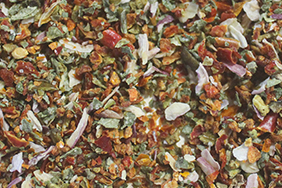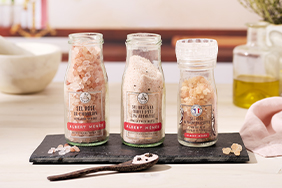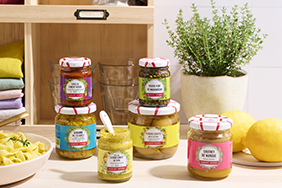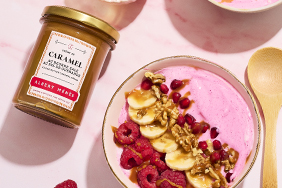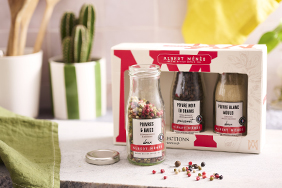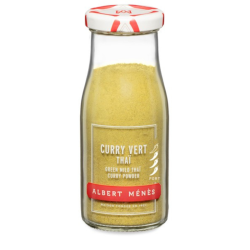-
MenuBack
-
SPICES IN A BAG
-
-
Our spices in a bag
-
Our spices in a bag
-
-
-
Texte 2
Add a touch of the Mediterranean with this blend, ideal as a sauce or at the end of cooking.
-
-
Texte 2
More than 50 large-format products in an economical and practical kraft bag.
-
Spices
-
-
-
Catégories
-
-
-
Texte 2
Une alliance parfaite entre l'ail et le piment qui donnera vie à vos plats avec une intensité envoûtante.
-
-
salts
Our exceptional Albert Ménès salts are real little jewels with bright colours and original flavours.
-
-
Deli
-
-
-
-
Texte 2
Let yourself be tempted by our quality seafood, carefully selected for you.
-
-
Texte 2
A real alternative to traditional spices, these accompaniments will enhance the flavour of your favourite dishes.
-
- Jams and Honeys
- Gifts
-
House
-
-
Categories 1
-
-
-
-
Texte 2
Since 1921, Albert Ménès has been pursuing the beautiful adventure of taste with greed and generosity.
- Our recipes
- Notre partenaire
- Contact us
-
MenuBack
-
SPICES IN A BAG
-
-
Our spices in a bag
-
Our spices in a bag
-
-
-
Texte 2
Add a touch of the Mediterranean with this blend, ideal as a sauce or at the end of cooking.
-
-
Texte 2
More than 50 large-format products in an economical and practical kraft bag.
-
Spices
-
-
-
Catégories
-
-
-
Texte 2
Une alliance parfaite entre l'ail et le piment qui donnera vie à vos plats avec une intensité envoûtante.
-
-
salts
Our exceptional Albert Ménès salts are real little jewels with bright colours and original flavours.
-
-
Deli
-
-
-
-
Texte 2
Let yourself be tempted by our quality seafood, carefully selected for you.
-
-
Texte 2
A real alternative to traditional spices, these accompaniments will enhance the flavour of your favourite dishes.
-
- Jams and Honeys
- Gifts
-
House
-
-
Categories 1
-
-
-
-
Texte 2
Since 1921, Albert Ménès has been pursuing the beautiful adventure of taste with greed and generosity.
- Our recipes
- Notre partenaire
- Contact us
Découvrez toutes nos recettes
Search in blog
Blog categories
Popular posts
-
 North African Couscous recipe: the real traditional quick and easy recipe!02/05/2021Posted in: Recipes296670 viewsThe real recipe for North African couscous An easy-to-make recipe that's impossible to beat!Read more
North African Couscous recipe: the real traditional quick and easy recipe!02/05/2021Posted in: Recipes296670 viewsThe real recipe for North African couscous An easy-to-make recipe that's impossible to beat!Read more -
 Poulet basquaise : the real traditional recipe28/02/2023Posted in: Recipes185433 viewsBasque chicken: a traditional and easy recipe with the flavours of the South-WestRead more
Poulet basquaise : the real traditional recipe28/02/2023Posted in: Recipes185433 viewsBasque chicken: a traditional and easy recipe with the flavours of the South-WestRead more -
 Tunisian Chakchouka18/10/2022Posted in: Recipes36474 viewsTunisian chakchouka with eggsRead more
Tunisian Chakchouka18/10/2022Posted in: Recipes36474 viewsTunisian chakchouka with eggsRead more -
 La piperade03/08/2023Posted in: Recipes26873 viewsLaissez vous transporter sur les terres basques en testant la recette de la piperade.Read more
La piperade03/08/2023Posted in: Recipes26873 viewsLaissez vous transporter sur les terres basques en testant la recette de la piperade.Read more -
 Tunisian couscous from the sea18/10/2022Posted in: Recipes26359 viewsTunisian white fish couscous with smoked organic Provence pepper harissa.Read more
Tunisian couscous from the sea18/10/2022Posted in: Recipes26359 viewsTunisian white fish couscous with smoked organic Provence pepper harissa.Read more
Featured posts
-
 Petit guide : Quels ingrédients pour une bonne raclette ?Plat typique des régions montagneuses, la raclette est devenue un repas d’hiver par excellence au fil des années. La...Read more
Petit guide : Quels ingrédients pour une bonne raclette ?Plat typique des régions montagneuses, la raclette est devenue un repas d’hiver par excellence au fil des années. La...Read more -

-
 Lemon, poppy seed and blueberry cake05/08/2025Posted in: Recipes731 viewsA moist, fruity and tangy cake: try our recipe for lemon and blueberry jam cake. A real treat!Read more
Lemon, poppy seed and blueberry cake05/08/2025Posted in: Recipes731 viewsA moist, fruity and tangy cake: try our recipe for lemon and blueberry jam cake. A real treat!Read more -
 Mustard crackers with Comté cheese and Provence herbs04/08/2025Posted in: Recipes796 viewsThe perfect quick recipe for your aperitifs: mustard crackers. Ready in 25 minutes, this recipe will be a hit.Read more
Mustard crackers with Comté cheese and Provence herbs04/08/2025Posted in: Recipes796 viewsThe perfect quick recipe for your aperitifs: mustard crackers. Ready in 25 minutes, this recipe will be a hit.Read more -
 Lebanese-style green beans18/06/2025Posted in: Recipes1299 viewsA classic of Levantine cuisine, Lebanese-style green beans appeal for their intense flavour and freshness. Served hot...Read more
Lebanese-style green beans18/06/2025Posted in: Recipes1299 viewsA classic of Levantine cuisine, Lebanese-style green beans appeal for their intense flavour and freshness. Served hot...Read more
Curry: everything you need to know about its origin and use
Curry: A Journey Through Flavors and Cultures
Curry is much more than just a blend of spices. It is a mix of flavors, aromas, and culinary traditions, rich with a millennia-old history. Over the centuries, curry has evolved, absorbing influences from various civilizations it encountered, becoming an essential part of global gastronomy today. Discover its history and the origin of the name "curry," the different existing varieties, and its culinary uses through this article.
HISTORY AND ORIGIN OF CURRY
The Origins of Curry
First of all, it is important to know that the term "curry" comes from the Tamil word "kari," which means sauce or stew. Thus, the word "curry" originally referred to a preparation rather than a specific dish or spice, but it has come to be used to denote this famous savory spice blend. However, there is still a distinction between the term "curry" used in the West to refer to the spice blend and the term "masala" used in Eastern countries to refer to the "mixture."
Curry, as we know it today, is thought to have appeared in the 18th century when spice blends were prepared by Indian merchants for members of the British colonial government returning to England. This is why curry is commonly perceived as a spice blend originating from India.
The earliest traces of this dish date back approximately 4,000 years, to the Indus Valley civilization, where inhabitants already used spice blends to season their dishes.
Over time, curry spread throughout Asia via trade and migration. Each region adapted the recipe based on local ingredients and culinary traditions, creating a multitude of variations.
The History of Curry
Curry, now globally recognized and enjoyed, has its roots in the ancient culinary practices of the Indian subcontinent. The history of curry is rich and complex, marked by cultural and commercial exchanges and the evolution of culinary techniques over the centuries.
According to ancient texts written around 1500 BC, the earliest traces of curry can be found in the Indus Valley civilization, which is now modern-day Pakistan and northwestern India. These early forms of curry were actually various spice blends, called "masala," which formed the basis of their dishes. The curry as we know it today began to spread beyond India from the 16th century, following the Mughal invasion of India. Colonial influence also played a crucial role in the dissemination of curry. The British, in particular, adopted curry during their colonization of India and brought it back to Europe. Curry then gained popularity in the United Kingdom, where it was adapted to local tastes, giving rise to dishes like "chicken tikka masala."
Today, curry is a globally recognized spice, appreciated for its diversity of flavors. Whether in India, Thailand, Japan, England, or the Caribbean, each version of curry tells a story of migration, innovation, and cultural integration.
Modern curry continues to evolve, influenced by global culinary trends and local preferences. Chefs around the world experiment with new ingredients and techniques, continuing the tradition of innovation that has always characterized this dish. From vegan curries to fusion curries incorporating elements of different cuisines, curry remains a blank canvas for culinary expression.
What is Curry Made Of?
There are almost as many versions of curry as there are people on earth. Being a blend of spices, it is easy to vary the recipes, which adds to the richness of this spice mix.
In India, the preparation of curry varies according to traditions, cultures, and regions. There are mild or spicy curries, curries with 10 ingredients or 35 ingredients, and even yellow or red curries.
Consumed for millennia in India, curry mainly consists of ginger, coriander, cardamom, cloves, fennel, cumin, fenugreek, garlic, and turmeric. These ingredients generally form the base of any curry.
Spices like turmeric and coriander are essential in the preparation of curry because they are used for their medicinal properties.
The preparation of this savory spice blend is relatively simple: all the mentioned spices are ground and, depending on the recipes, sometimes toasted. They are then dried, resulting in the curry powder we know.

THE DIFFERENT TYPES OF CURRY
Curry, Curry Powder, Curry Paste, and Curry Leaves
Curry is a subject full of nuances. Besides the fact that the term and recipes differ by country and region, it is also important to differentiate between curry, curry powder, and curry leaves.
As explained, curry refers to a saucy dish that is usually simmered with spices for a long time.
Curry powder is a blend of spices that are finely mixed to produce the curry we all know.
Curry paste, on the other hand, is a mix of spices similar to curry powder but combined with a fat such as peanut oil, sesame oil, or sunflower oil.
Finally, curry leaves can be compared to bay leaves. They are the leaves of the curry tree, used whole like a bouquet garni or crushed and added to culinary preparations.
Different Varieties
Despite the diversity of curries around the world, they can still be categorized.
We can group them into three main categories based on their types: yellow curry, red curry, and Thai curry. Alternatively, they can be grouped into three categories based on their intensity: mild curry, medium curry, and hot curry.
There is no shortage of varieties; you may have heard of Madras curry, Balti curry, Thai curry, Indian curry, or even Japanese curry.
Indian curry is perhaps the most famous, with distinct regional variations such as Punjabi curry, which is rich and creamy, often made with butter and cream, and Kerala curry, which uses a lot of coconut milk and seafood. The spices used in Indian curries also vary by region and dish, including blends of garam masala, curry powder, and many other spices. In Thailand, curry takes on a different dimension with the use of curry pastes, made from fresh ingredients such as chili, lemongrass, galangal, and kaffir lime leaves. Thai curries are often classified by color – red, green, and yellow – with each color representing a specific set of spices and ingredients. Japanese curry, on the other hand, is a legacy of British influence during the Meiji era. Unlike its Asian counterparts, Japanese curry is milder and thicker, often served with rice and vegetables, and flavored with a sauce based on apples and honey.

USING CURRY IN COOKING
Curry is a versatile and aromatic ingredient that can transform an ordinary dish into a burst of flavors. Whether in the form of powder, paste, or leaves, curry offers a multitude of culinary possibilities.
Using Curry Powder
- Indian Curries: Curry powder is ideal for Indian dishes such as chicken curry, vegetable curry, or lentil curry. Sauté onions, garlic, and ginger in oil, add curry powder, then incorporate other ingredients (meat, vegetables, lentils) and let simmer.
- Soups and Stews: Add a tablespoon of curry powder to your soups and stews for a spicy and comforting flavor. For example, carrot curry soup or potato and chickpea curry stew.
- Marinades: Mix curry powder with yogurt, lemon juice, and oil to create a flavorful marinade for chicken, fish, or tofu. Let marinate for a few hours before cooking.
Using Curry Paste
- Thai Curries: Red, green, and yellow curry pastes are essential for Thai curries. Sauté the paste in oil until it releases its aroma, then add coconut milk, proteins (chicken, shrimp, tofu), and vegetables. Let simmer until fully cooked.
- Tom Kha Soup: Make Tom Kha soup using red or green curry paste. Simmer with coconut milk, chicken broth, galangal, lemongrass, and mushrooms for a fragrant and spicy soup.
- Marinades and Sauces: Mix curry paste with coconut milk or yogurt for a rich and aromatic marinade. Use it as a base for sauces to drizzle over grilled or roasted dishes.
Beyond the traditional dishes commonly associated with curry, you can use this spice blend daily by sprinkling it on potatoes, omelets, savory cakes, or even in desserts for the more adventurous.
How to Make Curry Sauce
Curry sauce is a versatile preparation that can accompany a variety of dishes, from meats to vegetables, fish, and seafood. You can enhance your dressings or mayonnaise with your choice of curry according to your taste. You can also make a yogurt-based sauce spiced up with shallots and curry, perfect for jazzing up your appetizers.
Alternatively, you can make a hot curry sauce by blending oil, onion, garlic, curry, spices, coconut milk, and vegetable broth. Simmer this sauce with tofu to marinate it or with vegetables or fish.
The origin of curry is a fascinating tale of travel and cultural exchange. Having traveled and evolved significantly, curry is now a symbol of global culinary richness and diversity. Each curry dish is a celebration of history, traditions, and innovation, uniting people across continents and generations.

Related products
-
Mild Curry Powder
Price: €4.85 -
Green Mild Thai Curry Powder
Price: €4.90 -
Red Hot Curry Powder
Price: €4.90 -
Seafood Curry Blend
Price: €4.99
Related posts
-
 Notre escapade bretonne...
Posted in: News04/05/20173813 viewsUne sélection pour les gastronomes amateurs d’iode et d’émotionRead more
Notre escapade bretonne...
Posted in: News04/05/20173813 viewsUne sélection pour les gastronomes amateurs d’iode et d’émotionRead more -
 Albert Ménès lauréat au Grand Prix Cuisine Actuelle 2017 !
11/12/20172390 viewsNous sommes fiers de vous annoncer l'élection de notre confit pour fromage au Grand Prix Cuisine Actuelle 2017 !Read more
Albert Ménès lauréat au Grand Prix Cuisine Actuelle 2017 !
11/12/20172390 viewsNous sommes fiers de vous annoncer l'élection de notre confit pour fromage au Grand Prix Cuisine Actuelle 2017 !Read more -
 Albert Ménès X Interflora
2724 viewsDécouvrez l'Automnépicé d'Albert Ménès et Interflora !Read more
Albert Ménès X Interflora
2724 viewsDécouvrez l'Automnépicé d'Albert Ménès et Interflora !Read more -
 Soutenez avec nous l’école de pâtisserie du Bayon
Posted in: News11/01/20182643 viewsNous avions à coeur de vous partager cette belle aventure, aussi gourmande que généreuse, aussi passionnée qu'engagée.Read more
Soutenez avec nous l’école de pâtisserie du Bayon
Posted in: News11/01/20182643 viewsNous avions à coeur de vous partager cette belle aventure, aussi gourmande que généreuse, aussi passionnée qu'engagée.Read more -
 Albert Ménès présent au Taste of Paris
Posted in: News02/03/20183069 viewsVenez nous rendre visite à Taste Of Paris du 17 au 20 Mai 2018, au Grand Palais !Read more
Albert Ménès présent au Taste of Paris
Posted in: News02/03/20183069 viewsVenez nous rendre visite à Taste Of Paris du 17 au 20 Mai 2018, au Grand Palais !Read more -
 Albert Ménès dans les boxs QuiToque
Posted in: News18/03/20182786 viewsA découvrir de toute urgence !Read more
Albert Ménès dans les boxs QuiToque
Posted in: News18/03/20182786 viewsA découvrir de toute urgence !Read more

